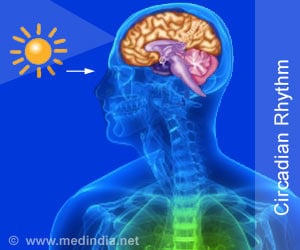When it comes to scheduling their days, fruit flies are pretty predictable, with peaks of activity at dawn and dusk and rest times in between.

"Our work clearly shows that light is detected by individual neurons that then communicate with each other to properly define the phase of circadian behavior," he added. "This emphasizes the importance of neural interaction in the generation of properly phased circadian rhythms."
In the brains of Drosophila fruit flies, there are approximately 150 circadian neurons, explained Emery and coauthor Yong Zhang, including a small group of morning oscillators that promote activity early in the day and another group of evening oscillators that promote activity later. Morning oscillators also set the pace of molecular rhythms in other parts of the brain, and hence the phase of circadian behavior. Scientists had thought they did this by relying heavily on their own sensitivity to light—what Emery calls "cell-autonomous photoreception." Indeed, these cells do express fruit flies' dedicated photoreceptor Cryptochrome (CRY). But recent evidence suggested that something was missing from that simple view.
In the new study, the researchers manipulated CRY's ability to function through another clock component, known as JET (short for Jetlag), in different circadian neurons and watched what happened. The studies show that light detection by the morning oscillators isn't enough to keep flies going about their business in a timely way. They need those evening oscillators too.
JET's role is bigger than expected as well. In addition to enabling cell-autonomous light sensing, the protein also allows distinct circadian neurons to talk to each other in rapid fashion after light exposure, although the researchers don't yet know how.
The new model also suggests that flies and mammals have more similarities than had been appreciated when it comes to synchronizing their activities to the sun, the researchers say. In mammals, specific neurons of the circadian pacemaker of the brain (known as the Suprachiasmatic Nucleus or SCN) receive light input from the retina. Those cells then communicate with pacemaker neurons, which resets the circadian network as a whole.
Advertisement









